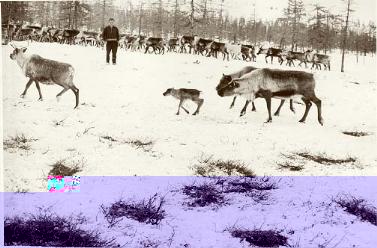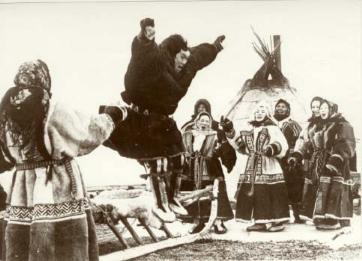
The indigenous populations of the Siberian region retained traditional concepts of the surrounding world and the universe over a long time period because of the particular features of their social, economic, and cultural evolution. Because of the nature of the economy, dependence on natural conditions, dispersion in small groups over the huge territory, and geographic remoteness, peoples of Siberia and the Far East retained many traditional elements of culture up to the beginning of the twentieth century, and some even up to the present. Included among these are hunting tools made of stone and bone, food- and hide-processing tools, and many articles of daily use.Valentina Gorbacheva
Russian Museum of Ethnography
In the early twentieth century, Siberia was one of the most remote and difficult regions to access in Russia. Literacy among the indigenous Siberian population at that time was less than one percent and none of the ethnic groups had its own written language. Almost no professional medical assistance was available. There was only one hospital for every 70,000 people and one doctor for every 13,000 people.
From the 1920s through the 1930s, the first radical changes in many aspects of the lives of Siberian peoples took place. On the initiative of the Committee of the North, a national policy of social and legal measures was implemented and national regions and national districts were established. Between 1929 and 1930 nine national districts were established; two of these (i.e., the Vitim-Olekma [Evenk] District and Okhotsk [Even] District) were soon abolished. District names were created using national and territorial principles (Nenets, Khants-Mansi, Even, Chukot, Koryak, Yamal-Nenets, and Taymyr/Dolgan-Nenets National Districts) that reflected the presence of one or several peoples, or a connection of one or more peoples, with the territory they inhabited.
The abolition in 1935 of the Committee of the North, an active initiator and conductor of the major changes, complicated the resolution of a number of issues, including national ones. At present, of the twenty-six ethnic groups in Siberia, nineteen have no administrative national status. They cannot defend their rights, particularly regarding natural-resource management and land use. The peoples who have their autonomy (since 1977 the National Districts have been transformed into Autonomous Districts) actively defend their rights for the use of natural resources in connection with industrial development. The majority of the districts (Chukot, Koryak, Yamal-Nenets, and Khants-Mansi) have become autonomous. All social and economic issues in the districts are discussed and resolved during sessions of the District Duma, the local legislative body, which includes representatives of the indigenous peoples.
Contemporary reindeer breeder with newborn reindeer. No. 823-1.

Currently, an insufficient number of personnel for reindeer breeding is an acute problem in many of the northern regions. This situation is the result of changes in the lifeways of the indigenous peoples of the North from the 1950s through the 1970s, including the establishment of a more settled mode of life; concentration of the population in central manors of state farms and settlements; keeping the children of reindeer breeders in boarding schools away from their parents in the winterspring period; and the loss of connection with the traditional forms of labor and household. Nevertheless, children of reindeer breeders retained their native language to a greater degree than did the children of hunters, fishermen, and marine hunters, who lived in permanent settlements with access to a wider variety of amenities.
Writing was established among peoples of Siberia in the 1930s, first on the basis of the Roman alphabet, later on the basis of the Russian alphabet. Teaching in the native language was introduced in the schools in 19671968. At present, primary teaching in the schools is conducted in the native language.
The native population of Siberia is bilingual, and the majority have a complete command of their native language as well as Russian. Newspapers and journals, educational literature, and fiction are published in two languages. Radio transmission and telecasts are also broadcast in two languages.
Nenet wedding celebration, 1983. No 83-8432.

Dance has a long tradition among the indigenous peoples of Siberia. It was associated with different rituals, feasts, and was of a cult nature. In the late 1950s and early 1960s a new style of dancing appeared, which depicts scenes from Siberian life. The dancing ensembles "Mengo," "Ergyron," "Oksiktakan," "Khayar," and the student ensemble "The Northern Lights" enjoy great popularity and are loved by audiences.
For many centuries the fine art of ethnic groups of the North and the Far East has been associated with mythological ideas, which formed the most important part of their cultural heritage. Their traditional artistic tastes are displayed in the sewing and embroidery of their clothes, shoes, and bags. Khants, Nenets, Koryak, and Chukchi decorate their clothes, shoes, bags and carpets with fanciful fur mosaics. Chukchi from the seacoast use leather appliqué; Khants use cloth appliqué. The art of these peoples characteristically depicts scenes from everyday life and animals in geometric designs. Nenets combine fur of different colors with red, green, and yellow woolen cloth, which makes their clothes bright and attractive. Embroidery with seed beads and colored and metallic threads is typical of the Evenk, Even, Dolgan, and Yakut.
Seacoast Chukchi and Koryak have long been famous for their art of carving and engraving of bone. Along with the traditional three-dimensional sculpture and colored engraving, bas-relief carving is also widely used. Master carvers of walrus tusks and whale bone are the pride of Chukotka. Carving of mammoth tusk, animal bone, and reindeer antler is a popular traditional art form in Yakutia. Local carvers depict animal scenes, scenes of national feasts and human history, and scenes from modern life. Many young artists of Chukotka and Yakutia continue the wonderful traditions of old masters. Under the influence of the cultures of other peoples of Russia, peoples of the Far North, Siberia, and the Far East are exploring new kinds of art that were unknown to them in the past, such as painting and black-and-white photography.
In the past few decades, industrial development of the North and widespread changes in Russia have brought about a number of new problems in areas of economic activity, law, and social-cultural aspects of life. Congresses of ethnic groups of the North and the established associations of peoples of the Far North actively participate in the discussion of these problems. They are working to develop measures for the conservation of the traditional Siberian cultures, which developed over a long period under the rigorous conditions of the North.